SEBAL-A: A Remote Sensing ET Algorithm that Accounts for Advection with Limited Data. Part I: Development and Validation
Abstract
:1. Introduction
1.1. Description of the Original SEBAL Model
1.2. EF Constancy throughout the Day
2. Materials and Methods
2.1. Study Area
2.2. Landsat Satellite Datasets and Processing
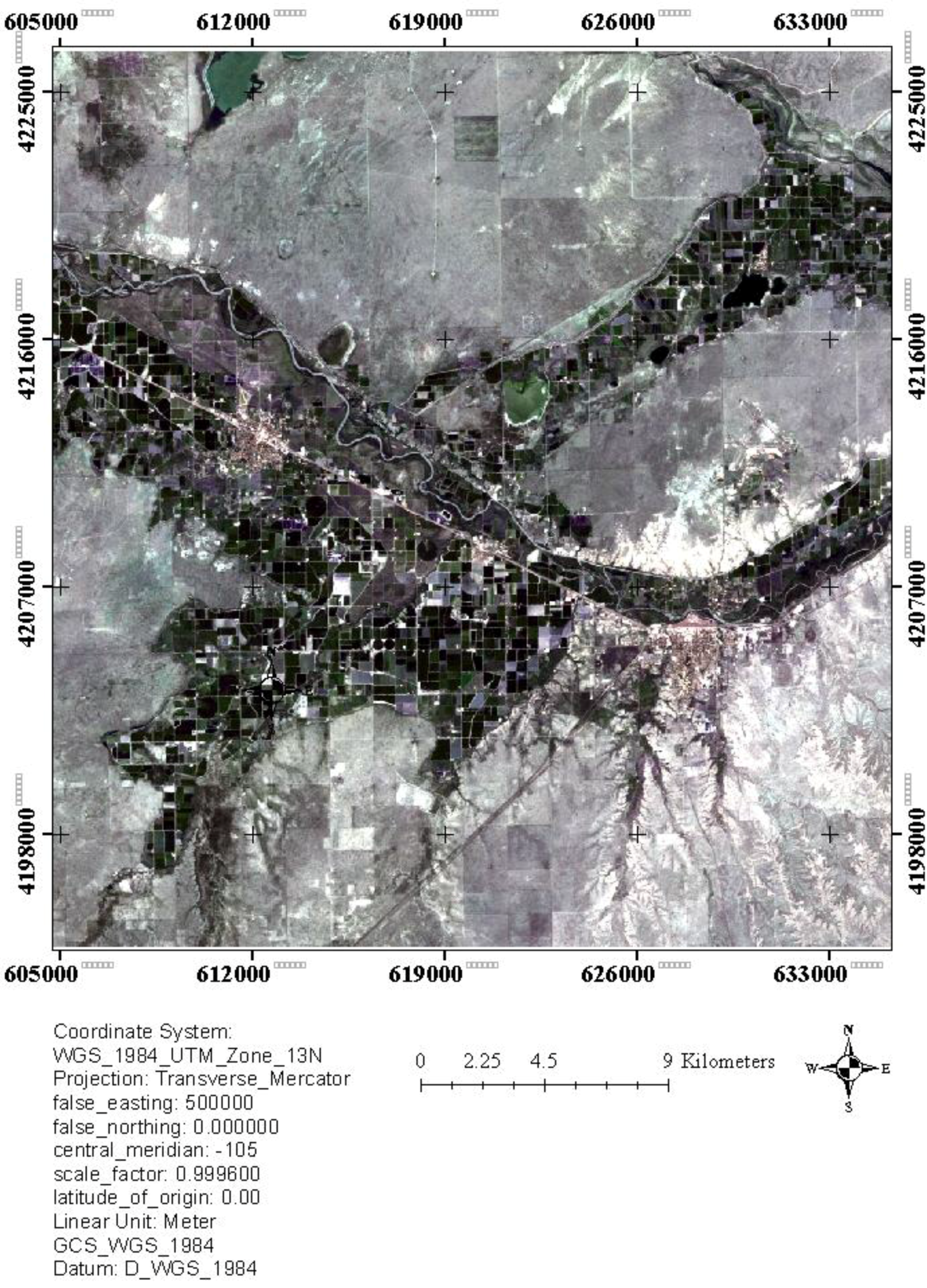
2.3. Evaluating SEBAL Performance under Advective Conditions
2.4. Development and Validation of the Modified SEBAL Model (SEBAL-A)
2.4.1. Data Requirement for Model Development
2.4.2. Description of the Model Development Process
- Using Equation (12), the advected energy (Ead) was determined as the difference between total latent energy, which is the energy equivalent of the lysimeter ET and the energy due to net solar radiation, which was measured using a net radiometer on site.
- The determined Ead was then equated to the product of VPD (es − ea) and the wind function, es and ea were calculated using weather stations parameters recorded at the station, and for f(u), Equations (17) and (18) were used in turn with β being the only unknown in the equation.
- To determine β, a set of the modeled ET was compared to lysimeter ET, from the calibration dataset, and using the solver function in MS Excel with an objective of obtaining the minimum RMSE.
2.5. Model Validation
3. Results and Discussions
3.1. Evaluation of SEBAL under Advective and Non-Advective Conditions
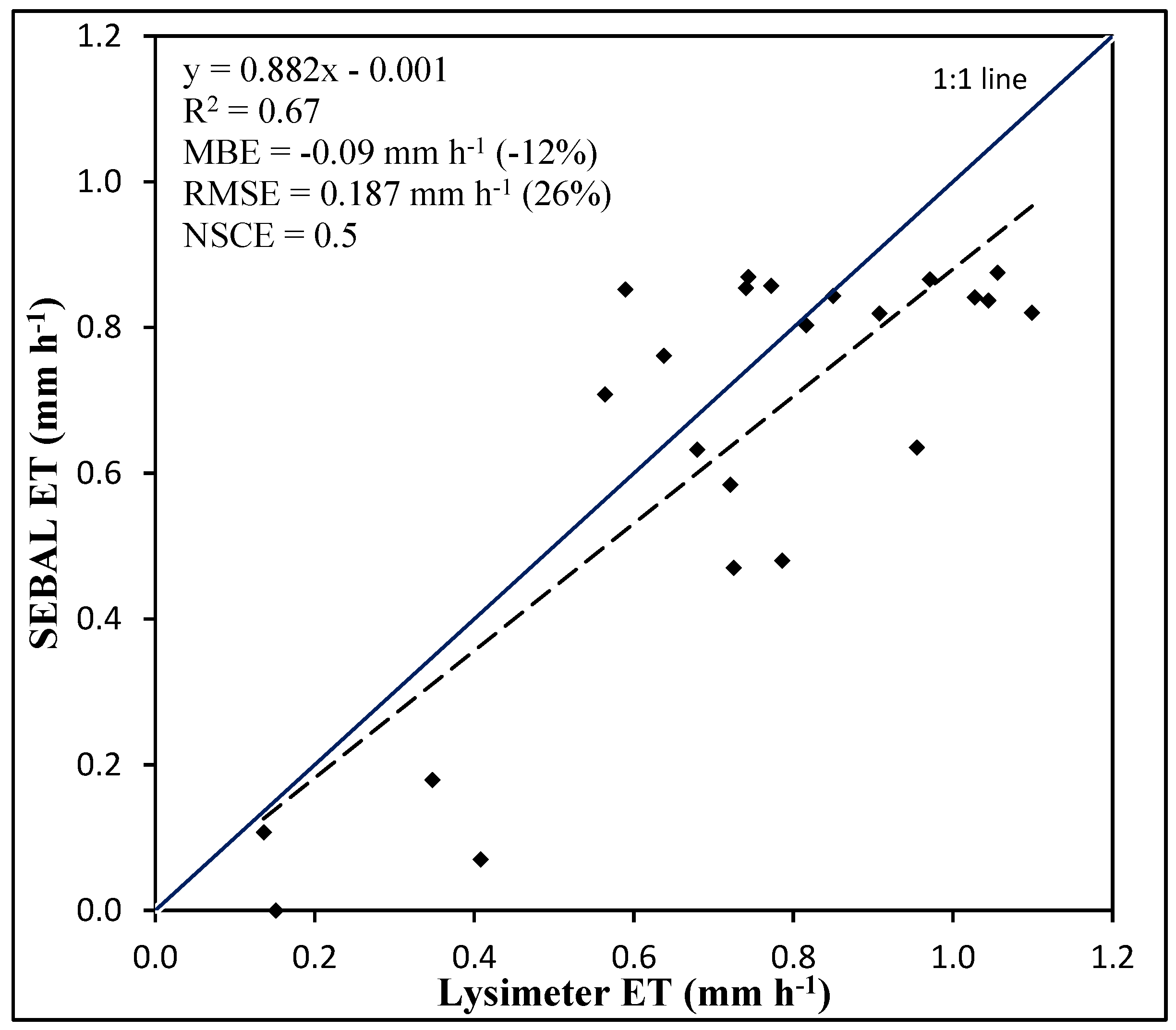
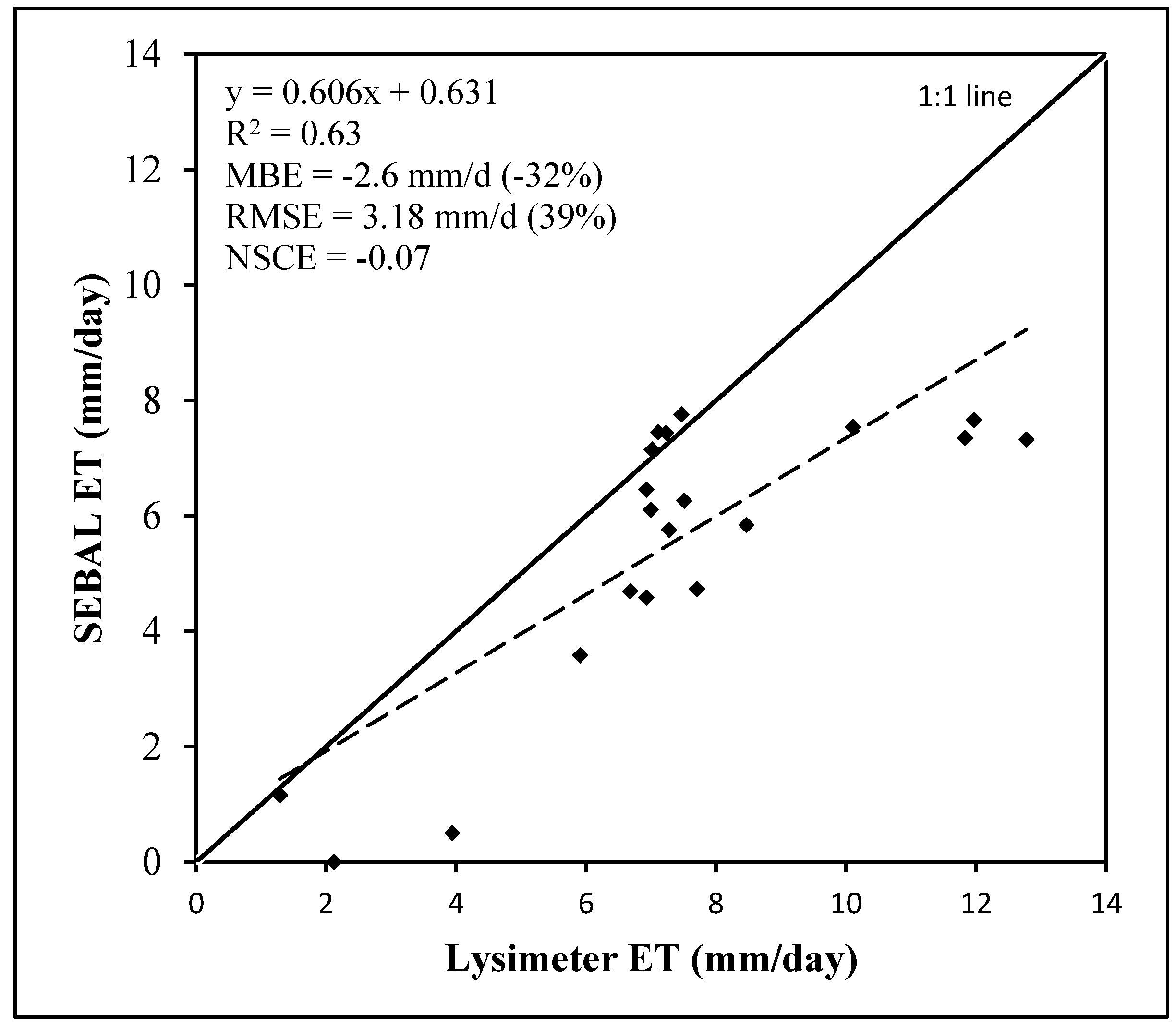
3.2. The Advective Effects of Wind, Humidity and Air Temperature
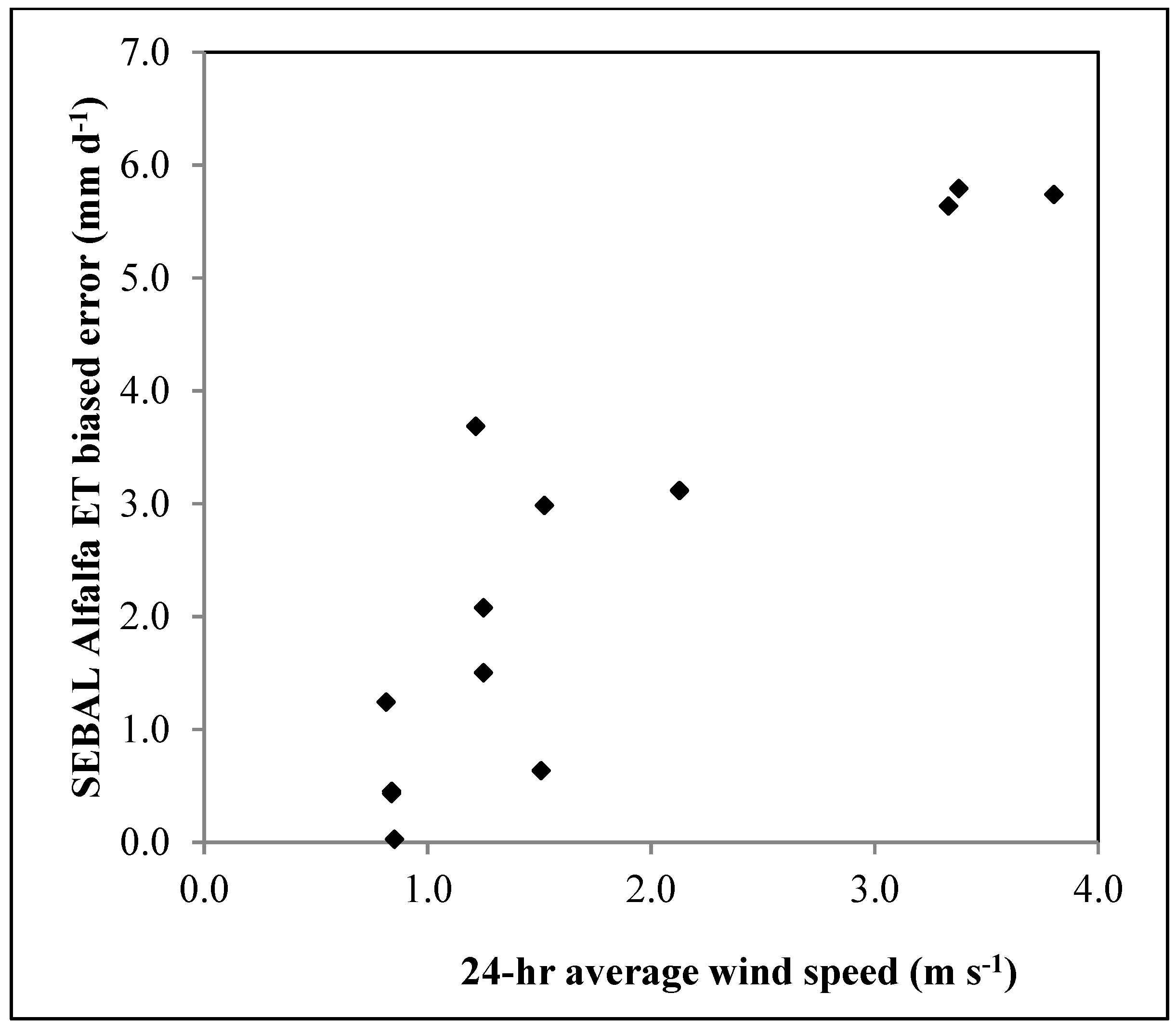

| Date | Ta (°C) | RH (%) | U (m·s−1) | h (cm) | Model error (%) | Night ET (mm) | |
|---|---|---|---|---|---|---|---|
| 24-hr | Afternoon | ||||||
| 6/15/2010 (A) | 19.2 | 66.7 | 1.4 | 3.2 | 30 | 9.3 | 0.4 |
| 7/1/2010 (A) | 24.8 | 47.7 | 3.3 | 3.7 | 66 | −35.5 | 1.1 |
| 8/18/2010 (A) | 24.3 | 55.5 | 0.8 | 0.9 | 55 | −2.7 | 0.4 |
| 5/6/2010 (A) | 16.2 | 40.7 | 4.3 | 8.4 | 43 | −15.0 | 0.7 |
| 5/22/2010 (A) | 23.2 | 28 | 3.8 | 5.3 | 60 | −35.6 | 1.4 |
| 8/10/2010 (A) | 23.0 | 69.1 | 0.9 | 1.0 | 50 | 0.6 | 0.0 |
| 8/26/2010 (A) | 22.1 | 46.6 | 1.8 | 2.6 | 12 | −34.1 | 0.4 |
| 6/15/2010 (B) | 18.8 | 70.1 | 1.4 | 2.5 | 104 | −14.7 | 0.2 |
| 5/6/2010 (B) | 15.7 | 42.9 | 3.6 | 6.8 | 60 | −28.2 | 1.0 |
| 5/22/2010 (B) | 22.1 | 32.3 | 3.0 | 4.0 | 92 | −40.3 | 2.1 |
| 8/10/2010 (B) | 23.7 | 63.5 | 1.0 | 1.0 | * | 2.1 | 0.2 |
| 6/18/2011 (A) | 22.1 | 50 | 2.4 | 3.7 | 25 | −14.7 | 0.5 |
| 7/4/2011 (A) | 24.4 | 49.8 | 1.1 | 2.7 | 70 | −21.0 | 0.1 |
| 8/21/2011 (A) | 23.7 | 62.9 | 1.3 | 1.7 | 70 | −11.7 | 0.3 |
| 6/18/2011 (B) | 22.2 | 50.3 | 2.4 | 3.5 | 18 | −32.2 | 0.7 |
| 8/5/2011 (B) | 23.9 | 64.3 | 0.9 | 0.9 | 48 | −3.7 | 0.6 |
| 6/4/2012 (B) | 22.6 | 46.6 | 2.7 | 5.2 | 25 | −22.4 | 0.4 |
| 6/4/2012 (A) | 22.4 | 47.7 | 2.8 | 5.6 | 32 | −26.2 | 0.6 |
| 6/20/2012 (A) | 23.1 | 43.6 | 3.4 | 3.5 | 76 | −32.2 | 1.7 |
| 7/22/2012 (A) | 27.0 | 36.4 | 1.6 | 2.8 | 53 | −39.8 | 1.1 |
3.3. Development and Validation of SEBAL-A
| Date | Lysimeter ET (mm·d−1) | SEBAL ET (mm·d−1) | SEBAL-A ET (mm·d−1) |
|---|---|---|---|
| 08/18/2010 (A) | 6.6 | 6.5 (−2.7) | 7.4 (12.2) |
| 09/19/2010 (A) | 6.5 | 4.6 (−29.9) | 6.0 (−8.9) |
| 10/05/2010 (A) | 5.6 | 3.6 (−38.9) | 4.8 (−13.6) |
| 08/05/2011(A) | 6.7 | 7.5 (10.9) | 8.3 (24.1) |
| 05/06/2010 (A) | 7.8 | 6.7 (−15.0) | 8.7 (11.8) |
| 05/22/2010 (A) | 11.1 | 7.2 (−35.6) | 10.4 (−6.5) |
| 08/10/2010 (A) | 5.7 | 5.8 (0.6) | 6.5 (13.5) |
| 08/05/2011(B) | 6.7 | 6.4 (−3.7) | 7.3 (9.4) |
| 07/04/2011(A) | 9.5 | 7.5 (−21.0) | 8.6 (−9.5) |
| 08/21/2011(A) | 7.1 | 6.3 (−11.7) | 7.3 (3.3) |
| 06/20/2012 (A) | 11.3 | 7.7 (−32.2) | 10.8 (−4.7) |
| 08/21/2011(B) | 6.5 | 6.1 (−5.6) | 7.1 (10.3) |
| Statistics | |||
| MBE | −1.3 (−17.1) | 0.17 (2.2) | |
| RMSE | 1.9 (25.1) | 0.83 (10.9) | |
| NSCE | −0.03 | 0.81 |
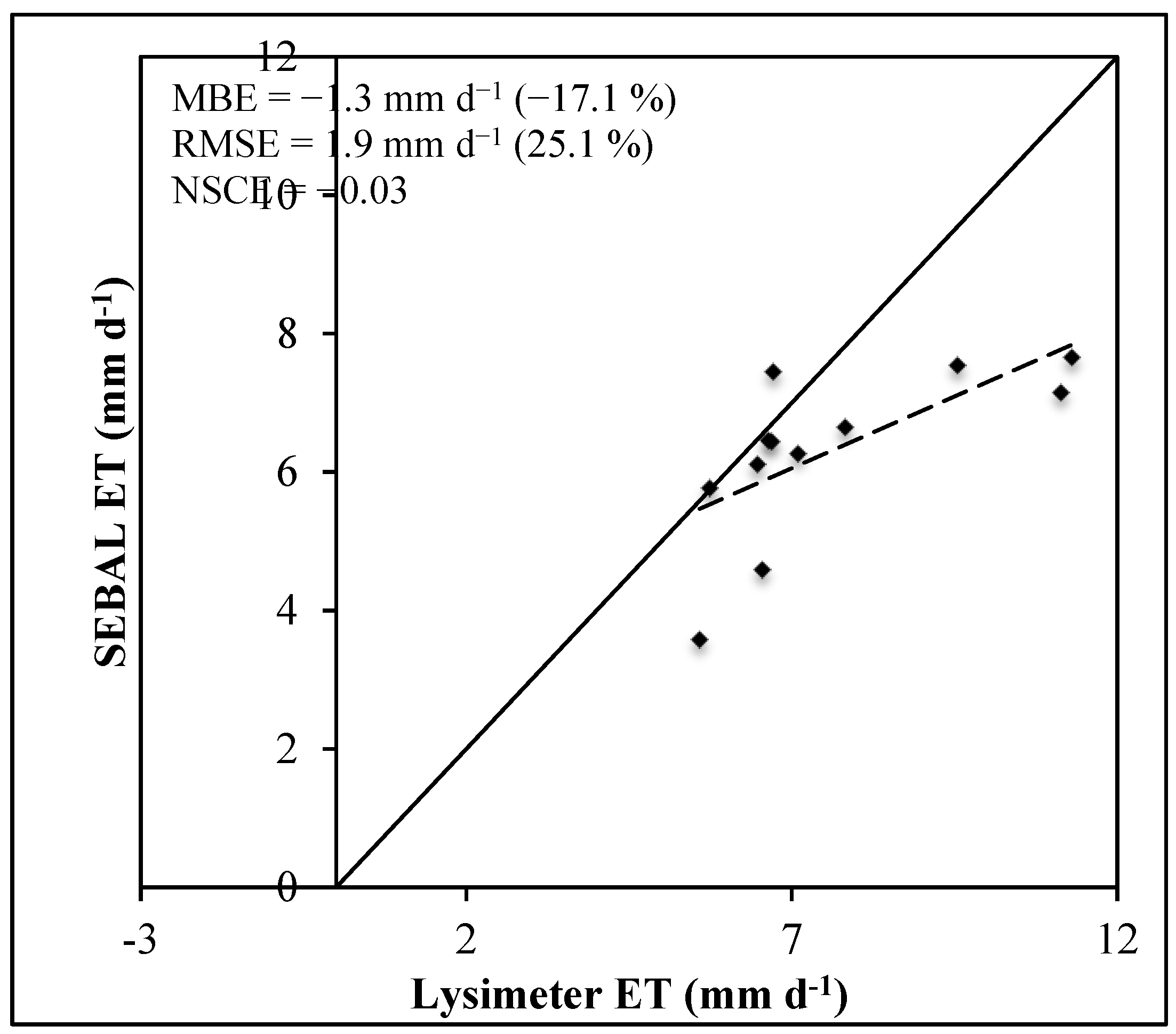
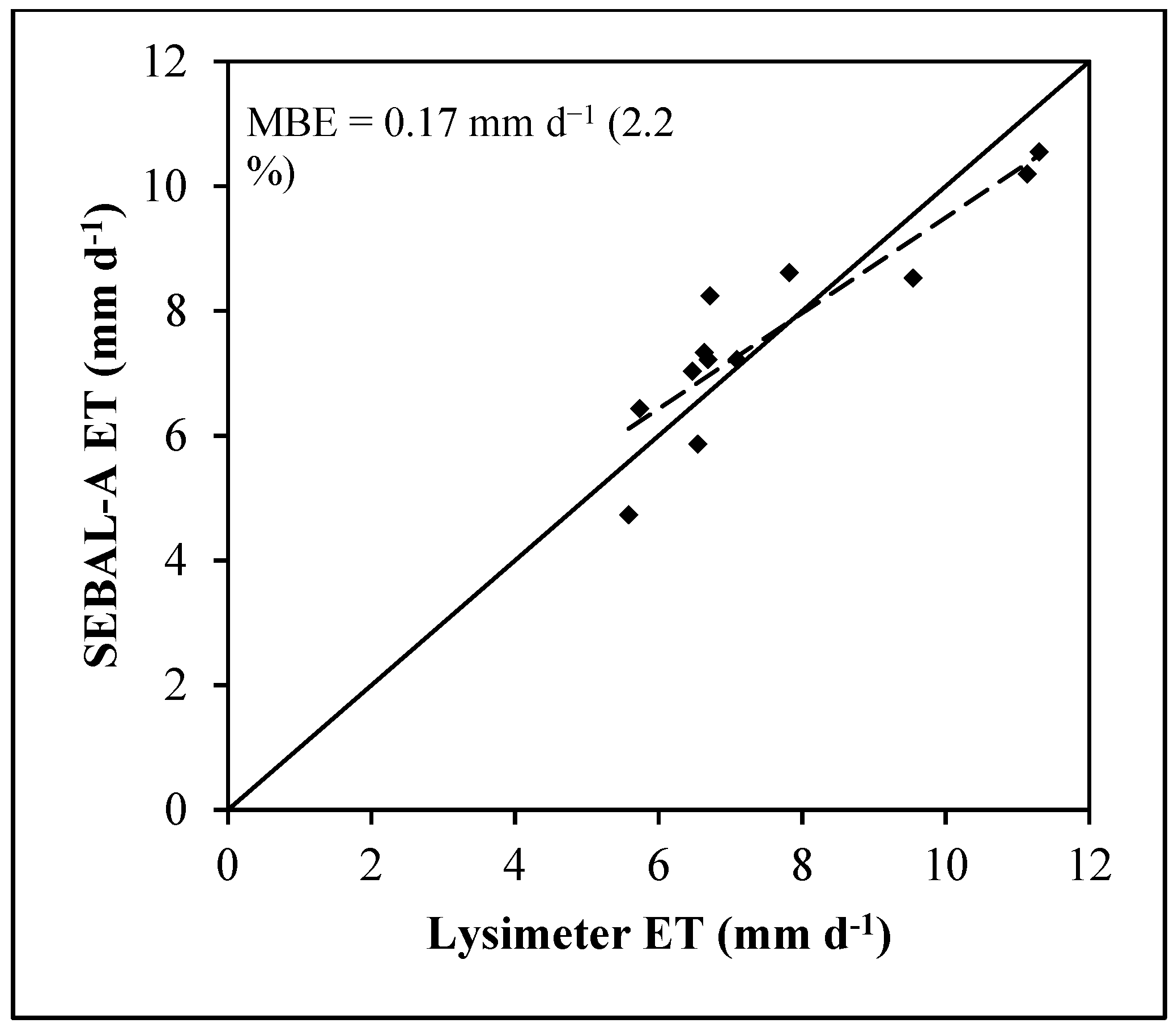
4. Conclusions
Acknowledgements
Author contributions
Conflicts of Interest
Appendix
| Date | Equation | RMSE/σ |
|---|---|---|
| 05/06/2010 | y = −29.580x + 318.51 | 0.27 |
| 05/22/2010 | y = −23.452x + 319.05 | 0.19 |
| 06/15/2010 | y = −17.154x + 311.00 | 0.11 |
| 06/18/2010 | y = −25.140x + 324.61 | 0.35 |
| 07/01/2010 | y = −23.876x + 319.45 | 0.26 |
| 07/04/2010 | y = −26.751x + 319.72 | 0.11 |
| 08/10/2010 | y = −19.177x + 314.49 | 0.18 |
| 08/18/2010 | y = −22.060x + 317.92 | 0.28 |
| 08/26/2010 | y = −32.753x + 323.80 | 0.36 |
| 08/05/2011 | y = −20.854x + 315.94 | 0.19 |
| 08/21/2011 | y = −21.436x + 315.84 | 0.15 |
| 06/20/2012 | y = −23.061x + 311.51 | 0.17 |
| 07/22/2012 | y = −31.111x + 317.43 | 0.29 |
References
- Bastiaanssen, W.G.M.; Menenti, M.; Feddes, R.A.; Holtslag, A.A.M. A remote sensing surface energy balance algorithm for land (SEBAL). 1. Formulation. J. Hydrol. 1998, 212–213, 198–212. [Google Scholar] [CrossRef]
- Allen, R.G.; Tasumi, M.; Trezza, R. Satellite-based energy balance for mapping evapotranspiration with internalized calibration (METRIC) model. ASCE J. Irrig. Drain. Eng. 2007, 133, 380–394. [Google Scholar] [CrossRef]
- Bastiaanssen, W.G.M.; Noordman, E.J.M.; Pelgrum, H.; Davids, G.; Thoreson, B.P.; Allen, R.G. SEBAL Model with remotely sensed data to improve water resources management under actual field conditions. J. Irrig. Drain. Eng. 2005, 131, 85–93. [Google Scholar] [CrossRef]
- Allen, R.G.; Tasumi, M.; Morse, A. Satellite-based evapotranspiration by energy balance for western states water management. In Proceedings of the World Water and Environmental Resources Congress, Anchorage, AL, USA, 15–19 May 2005; pp. 1–18.
- Allen, R.; Irmak, A.; Trezza, R.; Hendrickx, J.M.H.; Bastiaanssen, W.; Kjaersgaard, J. Satellite-based ET estimation in agriculture using SEBAL and METRIC. Hydrol. Process. 2011, 25, 4011–4027. [Google Scholar] [CrossRef]
- Hoedjes, J.C.B.; Chehbouni, A.; Jacob, F.; Ezzahar, J.; Boulet, G. Deriving daily evapotranspiration from remotely sensed instantaneous evaporative fraction over olive orchard in semi-arid Morocco. J. Hydrol. 2008, 354, 53–64. [Google Scholar] [CrossRef]
- Gentine, P.; Entekhabi, D.; Polcher, J. The diurnal behaviour of evaporative fraction in the soil-vegetation-atmospheric boundary layer continuum. J. Hydrometeorol. 2011, 12, 1530–1546. [Google Scholar] [CrossRef]
- Gowda, P.H.; Howell, T.A.; Paul, G.; Colaizzi, P.D.; Marek, T.H. SEBAL for estimating hourly ET fluxes over irrigated and dryland cotton during BEAREX08. In Proceedings of the World Environmental and Water Resources Congress, Palm Springs, CA, USA, 22–26 May 2011; pp. 2787–2795.
- Singh, R.K.; Irmak, A.; Irmak, S.; Martin, D.L. Application of SEBAL Model for mapping evapotranspiration and estimating surface energy fluxes in South-Central Nebraska. J. Irrig. Drain. Eng. 2008, 134, 273–285. [Google Scholar] [CrossRef]
- Bastiaanssen, W.G.M. Regionalization of Surface Flux Densities and Moisture Indicators in Composite Terrain: A Remote Sensing Approach under Clear Skies in Mediterranean Climates. Ph.D. Dissertation, CIP Data Koninklijke Bibliotheek, Den Haag, The Netherlands, 1995. [Google Scholar]
- Trezza, R. Evapotranspiration Using a Satellite-Based Surface Energy Balance with Standardized Ground Control. Ph.D. Dissertation, Biological and Irrigation Engineering Department, Utah State University, Logan, UT, USA, 2002. [Google Scholar]
- Brutsaert, W.; Sugita, M. Application of self-preservation in the diurnal evolution of the surface energy budget to determine daily evaporation. J. Geophys. Res. 1992. [Google Scholar] [CrossRef]
- Crago, R.D.; Brutsaert, W. Daytime evaporation and the self-preservation of the evaporative fraction and the Bowen ratio. J. Hydrol. 1996, 178, 241–255. [Google Scholar] [CrossRef]
- Stewart, J.B. Extrapolation of evaporation at time of satellite overpass to daily totals. In Scaling up in Hydrology Using Remote Sensing; Stewart, J.B., Engman, E.T., Feddes, R.A., Kerr, Y., Eds.; Wiley: Chichester, UK, 1996; pp. 245–255. [Google Scholar]
- Lhomme, J.P.; Elguero, E. Examination of evaporative fraction diurnal behavior using a soil-vegetation model coupled with a mixed-layer model. Hydrol. Earth Syst. Sci. 1999, 3, 259–270. [Google Scholar] [CrossRef]
- Irmak, A.; Allen, R.G.; Kjaersgaard, J.; Huntington, J.; Kamble, B.; Trezza, R.; Ratcliffe, I. Operational remote sensing of ET and challenges. In Evapotranspiration—Remote Sensing and Modeling; Irmak, A., Ed.; InTech: Rijeka, Croatia, 2012; Available online: http://www.intechopen.com/books/evapotranspiration-remote-sensing-and-modeling/operational-remote-sensing-of-et-and-challenges (accessed on 28 September 2015). [CrossRef]
- Marek, T.; Piccinni, G.; Schneider, A.; Howell, T.; Jett, M.; Dusek, D. Weighing lysimeters for the determination of crop water requirements and crop coefficients. Appl. Eng. Agric. 2006, 22, 851–856. [Google Scholar] [CrossRef]
- Badeck, F.W.; Bondeau, A.; Bottcher, K.; Doktor, D.; Lucht, W.; Schaber, J.; Sitch, S. Responses of spring phenology to climate change. New Phytol. 2004, 162, 295–309. [Google Scholar] [CrossRef]
- Woonsook, H.; Gowda, P.H.; Howell, T.A.; Paul, G.; Hernandez, J.E.; Basu, S. Downscaling surface temperature image with TsHARP. In Proceedings of the 5th National Decennial Irrigation Conference, Phoenix Convention Center, Phoenix, AZ, USA, 5–8 December 2010. [CrossRef]
- Allen, R.G.; Robison, C.W.; Garcia, M.; Kjaersgaard, J. Enhanced resolution of evapotranspiration by sharpening the Landsat thermal band. In Proceedings of the ASPRS-Pecora 17 Fall 2008 Conference, Denver, CO, USA, 18–20 November 2008; Available online: http://www.researchgate.net/publication/255665728 (accessed on 28 September 2015).
- Agam, N.; Kustas, W.P.; Anderson, M.C.; Li, F.; Colaizzi, P.D. Utility of thermal image sharpening for monitoring field-scale evapotranspiration over rainfed and irrigated agricultural regions. Geophys. Res. Lett. 2008. [Google Scholar] [CrossRef]
- Karnieli, A.; Bayasgalan, M.; Bayarjargal, Y.; Agam, N.; Khudulmur, S.; Tucker, C.J. Comments on the use of the vegetation health index over Mongolia. Int. J. Remote Sens. 2006, 27, 2017–2024. [Google Scholar] [CrossRef]
- Kustas, W.P.; Norman, J.M. Evaluating the effects of sub-pixel heterogeneity on pixel average fluxes. Remote Sens. Environ. 2000, 74, 327–342. [Google Scholar] [CrossRef]
- Wilmott, C.J. Some comments on the evaluation of model performance. Bull. Am. Meteorol. Soc. 1982, 63, 1309–1313. [Google Scholar] [CrossRef]
- Katiyar, A.K.; Kumar, A.; Pandey, C.K.; Das, B. A comparative study of monthly mean daily clear sky radiation over India. In. J. Energy Environ. 2010, 1, 177–182. [Google Scholar]
- Moriasi, D.N.; Arnold, J.G.; Van Liew, M.W.; Bingner, R.L.; Harmel, R.D.; Veith, T.L. Model evaluation guidelines for systematic quantification of accuracy in watershed simulations. Trans. ASABE 2007, 50, 885–900. [Google Scholar] [CrossRef]
- Nash, J.E.; Sutcliffe, J.V. River flow forecasting through conceptual models part 1—A discussion of principles. J. Hydrol. 1970, 10, 282–290. [Google Scholar] [CrossRef]
- Mkhwanazi, M.; Chávez, J.L.; Andales, A.A.; DeJonge, K. SEBAL-A: A remote sensing ET algorithm that accounts for advection with limited data. Part II: Test for transferability. Remote Sens. 2015, 7, 15068–15081. [Google Scholar] [CrossRef]
- McNaughton, K.G. Evaporation and advection I: Evaporation from extensive homogenous surfaces. Quart. J. R. Met. Soc. 1976, 102, 181–191. [Google Scholar] [CrossRef]
- Hobbins, M.T.; Ramirez, J.A.; Brown, T.C. The complementary relationship in estimation of regional evapotranspiration: An enhanced Advection-Aridity model. Water Resour. Res. 2001, 37, 1389–1403. [Google Scholar] [CrossRef]
- Tolk, J.A.; Evett, S.R.; Howell, T.A. Advection influences on evaporation of alfalfa in a semiarid climate. Agron. J. 2006, 98, 1646–1654. [Google Scholar] [CrossRef]
- Penman, H.L. Natural evaporation from open water, bare soil and grass. Proc. R. Soc. Lond. A 1948, 193, 120–146. [Google Scholar] [CrossRef]
- Brutsaert, W.; Stricker, H. An advection-aridity approach to estimate actual regional evapotranspiration. Water Resour. Res. 1979, 15, 443–450. [Google Scholar] [CrossRef]
- Stigter, C.J. Assessment of the quality of generalized wind functions in Penman’s equations. J. Hydrol. 1980, 45, 321–331. [Google Scholar] [CrossRef]
- Wright, J.L. Derivation of alfalfa and grass reference evapotranspiration. In Evapotranspiration and Irrigation Scheduling, Proceedings of the International Conference, ASAE, San Antonio, TX, USA, 3–6 November 1996; Camp, C.R., Sadler, E.J., Yoder, R.E., Eds.; pp. 133–140.
- Gowda, P.H.; Chavez, J.L.; Colaizzi, P.D.; Evett, S.R.; Howell, T.A.; Tolk, A.T. ET mapping for agricultural water management: Present status and challenges. Irrig. Sci. 2008, 26, 223–237. [Google Scholar] [CrossRef]
- Chávez, J.L.; Gowda, P.H.; Howell, T.A.; Neale, C.M.U.; Copeland, K.S. Estimating hourly crop ET using a two-source energy balance model and multispectral airborne imagery. Irrig. Sci. 2009, 38, 79–91. [Google Scholar] [CrossRef]
- Hipps, L.; Kustas, W. Patterns and organisation in evaporation. In Spatial Patterns in Hydrological Processes: Observations and Modelling; Grayson, R.B., Biöschl, G., Eds.; Cambridge University Press: New York, NY, USA, 2000; pp. 105–122. [Google Scholar]
- De Bruin, H.A.R.; Hartogensis, O.K.; Allen, R.G.; Kramer, J.W.J.L. Regional Advection Pertubations in an Irrigated Desert (RAPID) experiment. Theor. Appl. Climatol. 2005, 80, 143–152. [Google Scholar] [CrossRef]
- Brakke, T.W.; Verma, S.B.; Rosenberg, N.J. Local and Regional Components of Sensible Heat Advection. J. Appl. Meteor. 1978, 17, 955–963. [Google Scholar] [CrossRef]
- Zermeño-Gonzalez, A.; Hipps, L.E. Downwind evolution of surface fluxes over a vegetated surface during local advection of heat and saturation deficit. J. Hydrol. 1997, 192, 189–210. [Google Scholar] [CrossRef]
© 2015 by the authors; licensee MDPI, Basel, Switzerland. This article is an open access article distributed under the terms and conditions of the Creative Commons Attribution license (http://creativecommons.org/licenses/by/4.0/).
Share and Cite
Mkhwanazi, M.; Chávez, J.L.; Andales, A.A. SEBAL-A: A Remote Sensing ET Algorithm that Accounts for Advection with Limited Data. Part I: Development and Validation. Remote Sens. 2015, 7, 15046-15067. https://doi.org/10.3390/rs71115046
Mkhwanazi M, Chávez JL, Andales AA. SEBAL-A: A Remote Sensing ET Algorithm that Accounts for Advection with Limited Data. Part I: Development and Validation. Remote Sensing. 2015; 7(11):15046-15067. https://doi.org/10.3390/rs71115046
Chicago/Turabian StyleMkhwanazi, Mcebisi, José L. Chávez, and Allan A. Andales. 2015. "SEBAL-A: A Remote Sensing ET Algorithm that Accounts for Advection with Limited Data. Part I: Development and Validation" Remote Sensing 7, no. 11: 15046-15067. https://doi.org/10.3390/rs71115046
APA StyleMkhwanazi, M., Chávez, J. L., & Andales, A. A. (2015). SEBAL-A: A Remote Sensing ET Algorithm that Accounts for Advection with Limited Data. Part I: Development and Validation. Remote Sensing, 7(11), 15046-15067. https://doi.org/10.3390/rs71115046








